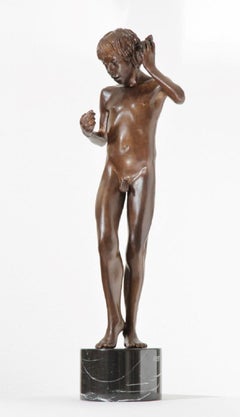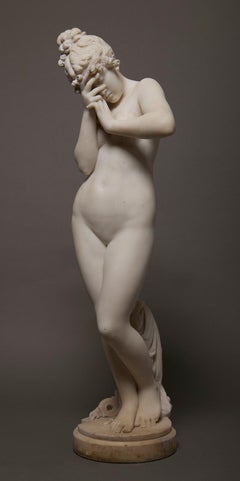Antonio Giovanni Lanzirotti Art
to
1
Overall Width
to
Overall Height
to
1
1
1
1
1
1
1
1
1
1
1
1
Artist: Antonio Giovanni Lanzirotti
Dealer: Antichità San Felice International Antiques
"La Danza", Grande scultura in Marmo bianco di Carrara XIX secolo
By Antonio Giovanni Lanzirotti
Located in Pistoia, IT
Antonio-Giovanni Lanzirotti, "La Danza", grande scultura in marmo bianco di Carrara, firmata AG Lanzirotti sulla base.
Antonio Giovanni Lanzirotti, nato a Palermo il 9 maggio 1839 e...
Category
1860s Italian School Antonio Giovanni Lanzirotti Art
Materials
Marble
Related Items
Aestus Bronze Sculpture Marble Stone Nude Boy Contemporary
By Wim van der Kant
Located in Utrecht, NL
Aestus Bronze Sculpture Marble Stone Nude Boy Contemporary
Wim van der Kant (1949, Kampen) is a selftaught artist. Next to his busy profession as a teacher ...
Category
21st Century and Contemporary Contemporary Antonio Giovanni Lanzirotti Art
Materials
Marble, Bronze
H 20.87 in W 3.94 in
Frine (Phryne), 19th Century Large Marble Sculpture of Nude Woman
Located in Beachwood, OH
Ercole Rosa (Italian, 1846 - 1893)
Frine (Phryne)
Marble
Signed 'E. Rosa, Studio O. Andreoni, Roma' on back
34.5 x 12 x 10 inches
80 lb.
Phryne was a 4th century BC famous Greek ...
Category
19th Century Italian School Antonio Giovanni Lanzirotti Art
Materials
Marble
H 34.5 in W 12 in D 10 in
Grand Tour Bronze Sculpture of Dionysus, 19th Century Italian School
Located in Beachwood, OH
19th Century Italian School
Grand Tour Bronze Sculpture of Dionysus, 19th Century
Bronze with black-green patination
24 x 10 x 10 inches
Dionysus, in Greco-Roman religion, a nature ...
Category
19th Century Italian School Antonio Giovanni Lanzirotti Art
Materials
Bronze
Pair of Italian "Alabaster Stone Lions" after Antonio Canova; Mid 19th Century
Located in SANTA FE, NM
"Pair Recumbent Stone Lions"
after Antonio Canova (1757-1822)
Italian (possibly Florence)
Mid 19th Century
Alabaster, marble
6 x 9 x 4 inches
This is an exquisite pair of Italian alabaster lions on marble bases based on the monumental lions carved by Antonio Canova (1757-1822), the greatest Italian neoclassical sculptor. Canova sculpted the marble lions for the monumental tomb of Pope Clement XIII in St. Peter’s, Rome in 1792
Canova Lions refers to the pair of copies of lion sculptures by Antonio Canova. When Canova created the sculptures in 1792, he installed them on the tomb of Pope Clement XIII. The marble sculptures are some of the most prominent features in St. Peter's Basilica in Rome. Given the intricacies of creating the original Canova lions, some artists created molds and replicated them. A good example is the pair of lion sculptures...
Category
1850s Italian School Antonio Giovanni Lanzirotti Art
Materials
Alabaster, Marble
SACRISTY DOOR
Located in Milano, IT
Antique Sacristy Door with Skull and Crossbones - Italy, 17th Century
Exceptional wooden vestry door, dating from the 17th century, from Italy. This unique piece was originally used...
Category
17th Century Italian School Antonio Giovanni Lanzirotti Art
Materials
Wood Panel
Hoop Dancer
By Demetre Chiparus
Located in Los Angeles, CA
Demetre Haralamb Chiparus (also known as Dumitru Chiparus) (16 September 1886 in Dorohoi, Romania - 22 January 1947 in Paris, France) was a Romanian Art Deco* era sculptor who lived and worked in Paris.
He was born in Romania, the son of Haralamb and Saveta. In 1909 he went to Italy, where he attended the classes of Italian sculptor Raffaello Romanelli. In 1912 he traveled to Paris to attend the Ecole des Beaux Arts* to pursue his art at the classes of Antonin Mercie and Jean Boucher.
Demetre Chiparus died in 1947 and was buried in Bagneux cemetery, just south of Paris.
The first sculptures of Chiparus were created in the realistic style and were exhibited at the Salon of 1914. He employed the combination of bronze and ivory, called chryselephantine*, to great effect. Most of his renowned works were made between 1914 and 1933. The first series of sculptures manufactured by Chiparus were the series of the children.
The mature style of Chiparus took shape beginning in the 1920s. His sculptures are remarkable for their bright and outstanding decorative effect. Dancers of the Russian Ballet, French theatre, and early motion pictures were among his more notable subjects and were typified by a long, slender, stylized appearance. His work was influenced by an interest in Egypt, after Pharaoh Tutankhamen's tomb was excavated.
He worked primarily with the Edmond Etling and Cie Foundry in Paris administrated by Julien Dreyfus. Les Neveux de J. Lehmann was the second foundry which constantly worked with Chiparus and produced the sculptures of his models.
Chiparus rarely exhibited at the Salon. In 1923 he showed his Javelin Thrower, and in 1928 exhibited his Ta-Keo dancer. During the period of Nazi persecution and the World War II, the foundries discontinued production of work by Chiparus. The economic situation of that time was not favorable to the development of decorative arts and circumstances for many sculptors worsened.
Since the early 1940s almost no works of Chiparus were sold, but he continued sculpting for his own pleasure, depicting animals in the Art Deco style. At the 1942 Paris Salon, the plaster sculptures Polar Bear and American Bison were exhibited, and in 1943 he showed a marble Polar Bear and plaster Pelican.
Sculptures of Dimitri Chiparus represent the classical manifestation of Art Deco style in decorative bronze ivory sculpture. Traditionally, four factors of influence over the creative activity of the artist can be distinguished: Serge Diaghilev's Ballets Russes, ancient Egyptian art, and French theatre. Early motion pictures were among his more notable subjects and were typified by figures with a long, slender, stylized appearance. Some of his sculptures were directly inspired by Russian dancers.
Quite often, Chiparus used the photos of Russian and French dancers, stars and models from fashion magazines of his time.
After the tomb of Tutankhamun was discovered in 1922, the art of ancient Egypt...
Category
1920s Art Deco Antonio Giovanni Lanzirotti Art
Materials
Marble, Bronze
Antique Italian Grand Tour Bronze Marble Bust Sculpture Dante Alighieri 1880
Located in Portland, OR
A good antique Italian Grand Tour Bronze and marble bust of Dante Alighieri, circa 1880.
The bronze is most likely Florentine and mod...
Category
Late 19th Century Italian School Antonio Giovanni Lanzirotti Art
Materials
Marble, Bronze
H 16 in W 19 in D 9 in
"Danzatrice"
Located in PARIS, FR
" Danzatrice " (Dancer)
by Marcello MASCHERINI (1906-1983)
A rare and tall bronze sculpture with a nuanced brownish green patina
Signed on the base " M. Mascherini "
Presented on a green marble base
Trieste – Italy...
Category
1950s Italian School Antonio Giovanni Lanzirotti Art
Materials
Bronze
NYDIA, THE BLIND FLOWER GIRL OF POMPEII Marble Sculpture 1856-1870
Located in Soquel, CA
Randolph John Rogers (American, 1825 - 1892) Randolph Rogers' Nydia, the Blind Flower Girl of Pompeii debuted in 1856 to critical and public acclaim, solidifying Rogers’ position as a pre-eminent American sculptor and it remains one of the artist’s most celebrated works today. The subject of Nydia is drawn from Edward Bulwer-Lytton's The Last Days of Pompeii 1834. After touring the ruins of the ancient city in 1833, and inspired by the stories of blinding volcanic ash, he composed the tale of Nydia, a slave who led her master, Glaucus, to safety. Rogers depicts Nydia at the moment that she and Glaucus have become separated in their perilous journey through the rubble and Nydia seeks familiarity in the surrounding chaos, her distress evident in her pained expression. The grace of the sculpture is at odds with the turmoil portrayed; a toppled Corinthian capital lies at her feet and obstructs her next step, indicated by the tilt of her back foot and grip on her walking stick. Examples of this model can be found in major American collections, including The Metropolitan Museum of Art, the Art Institute of Chicago, the Detroit Institute of Arts, the Los Angeles County Museum of Art, and the Museum of Fine Arts, Boston.
Literature, Millard F Rogers, Jr. Randolph Rogers, American Sculptor in Rome. University of Massachusetts Press, 1971, American Figurative Sculpture in the Museum of Fine Arts Boston. Museum of Fine Arts, Boston, 1986. Joyce K Schiller. "Nydia, A Forgotten Icon of the Nineteenth Century." Bulletin of the Detroit Institute of Arts,
Born in Waterloo, New York, Randolph John Rogers became an expatriate* sculptor of idealized figures, portraits, and commemorative works in Neo-Classical* and Realist* styles. He worked in clay, plaster, marble and bronze, and lived both in Italy and the United States. He made 167 examples of Nydia in two sizes (varies depending on base height) 36" and 54'.
Rogers was raised in Ann Arbor, Michigan, and as a young man did woodcuts* for the local newspaper, The Michigan Argus, and also worked as a baker's assistant and a dry goods clerk. In 1847, he moved to New York City, where he hoped to find work as an engraver*, but failing to do so, worked in a dry goods store owned by John Steward...
Category
1850s Italian School Antonio Giovanni Lanzirotti Art
Materials
Marble
Musidora
Located in PARIS, FR
"Musidora"
by Odoardo FANTACCHIOTTI (1809-1877)
Sculpture made in white Carrara marble
signed on the side on the base " O. Fantacchiotti "
Italy
around 1862
height 110 cm
diameter ...
Category
1860s Italian School Antonio Giovanni Lanzirotti Art
Materials
Marble
Monumental Italian Rationalist Marble Sculptures of Young Athletes
Located in Rome, IT
This monumental pair of sculptures in "Bardiglio" marble represent Greek Athletes figure , on a cylindrical base . Exaltation of the male strength and beauty, inspired by the trend i...
Category
1960s Modern Antonio Giovanni Lanzirotti Art
Materials
Marble
Art Deco Sculpture "Girl with flaming torches", by Ferdinand Preiss
By Ferdinand Preiss
Located in Berlin, DE
Art Deco cold-painted bronze on stepped black marble base, circa 1920. By Johann Philipp Ferdinand Preiss ( Germany 1882-1943 ).
Model number: 1084, signed: F Preiss...
Category
Early 20th Century Art Deco Antonio Giovanni Lanzirotti Art
Materials
Marble, Bronze
H 14.57 in W 6.68 in D 9.84 in
Antonio Giovanni Lanzirotti art for sale on 1stDibs.
Find a wide variety of authentic Antonio Giovanni Lanzirotti art available for sale on 1stDibs. You can also browse by medium to find art by Antonio Giovanni Lanzirotti in marble, stone and more. Not every interior allows for large Antonio Giovanni Lanzirotti art, so small editions measuring 13 inches across are available. Antonio Giovanni Lanzirotti art prices can differ depending upon medium, time period and other attributes. On 1stDibs, the price for these items starts at $13,890 and tops out at $13,890, while the average work can sell for $13,890.

